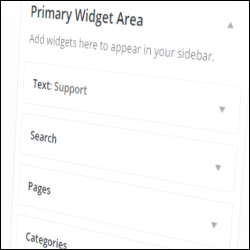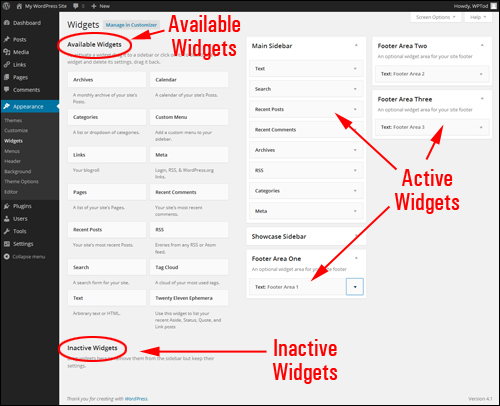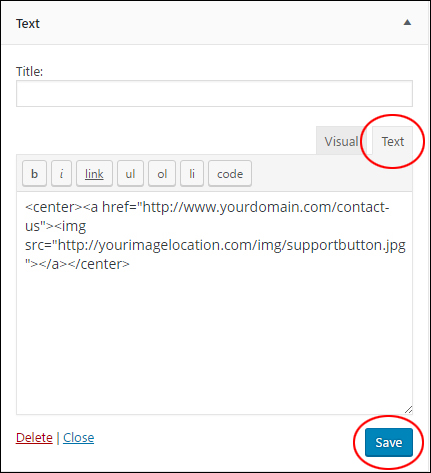 In Part 1 of this step-by-step tutorial series, we explained the basics of using WordPress widgets.
In Part 1 of this step-by-step tutorial series, we explained the basics of using WordPress widgets.
In this tutorial you will learn how to configure various commonly-used WordPress widgets.
Sidebar Widget Configuration
In a default WordPress installation, your site comes with a number of preinstalled widgets that can be used out of the box with little to no configuration required, such as widgets that let you display links to your pages, filter posts by categories, news items, add search features, etc.

(In a default WordPress installation, your site comes with a number of preinstalled widgets)
Adding Widgets To The WordPress Sidebar: Tutorial
In this step-by-step tutorial series, you will add, configure and reorder various commonly-used widgets, including:
- Add a Help button linking visitors to your help page.
- Adding a Categories section with a drop down menu.
- Adding a Recent Posts section to display the latest posts.
- Adding a list of your site’s Pages.
- Display useful Links on your sidebar section.
- Display news items using an RSS Feed section.
- Add a list of clickable tags through a Tag Cloud.
- Configure how Archived Posts display on the sidebar navigation area.
The Widgets area is located inside the WP administration area and can easily be accessed from the WordPress administration menu by going to Appearance > Widgets …

(WordPress Widgets Menu)
This loads the Widgets section in your web browser …

(Widgets Section)
Let’s start by configuring WordPress text widgets …
Text Widgets
Text widgets are versatile …

(WordPress Text widget)
![]()
Rich Text Widget
From version 4.8 onward, WordPress has added native rich-text editing capabilities to text widgets …

(Rich Text Widget)
This lets you quickly and easily format text, create lists, add emphasis, and insert links into your sidebar text …

(Format text easily with the new text widget)
A text widget lets you insert just about anything you want into your sidebar or other widget sections, such as lists of favorite items, videos, scripts and more to your site … simply type in text or add HTML into the content area. You can also add an optional title in the Title field. Remember to save your settings …

(A text widget is very useful!)
Example: Using A Text Widget To Add A Contact Button To Your Sidebar Navigation Section
For this example, we’ll set up a help button on your sidebar navigation section that takes visitors to a page on your site (or an external site, e.g. a helpdesk) where they can contact you for help and support.
First, create or source a “help button” graphic image that you can use on your own site …

We’ll set up the clickable button to display at the top of your sidebar like in the example shown below …

Step 1 – Upload your image.
To display the clickable button image on your site, the button image must be uploaded to your server. Upload your image to your server and write down the URL pointing to your image location.
For example …
http://www.yourdomain.com/images/supportbutton.jpg
You will use this information in Step 3.
For someone to go to the contact page when they click on the help button, you will need to either create a contact page, or have an existing destination page already set up (e.g. a helpdesk). We will then link the button image to this URL in Step 3 …
Step 2 – Create the contact page.
Create a contact page on your site and note down its URL …

Step 3 – Create the code for your text widget.
Don’t worry … this sounds a lot more technical than it is. Basically, you just need to create the instructions for your clickable button.
Your instructions can be written a simple text file and will look something like this …

- Replace “http://www.yourdomain.com/contact-us” in the code above with the URL of your contact page location.
- Replace “http://yourimagelocation.com/img/supportbutton.jpg” in the code with the URL of your image location.
The image below shows which sections of the above sample code you will need to replace with your actual contact details …

Replace the above URLs and then copy the above code to your clipboard when finished.
If you need help with basic HTML code, see this tutorial:
Now, go back into your Widgets screen …

(Widgets Screen)
Step 4 – Add a Text widget.
Add a Text widget to your sidebar where you would like your button to display.
In the Available Widgets area, select the Text widget …

(Text widget)
Drag the Text widget to the Active Widgets section and release it at the very top of the Widget Area …

(Dragging and dropping your Text widget)
Step 5 – Configure the widget settings.
Click on the widget title bar to configure its options. Paste the code with the links to your contact page and graphic button into the text widget content area and click save …

Add a title to the widget if you want (e.g. “Need Help?”, “Support”, etc.) and paste the code with the correct destination links into the Content area, then click Save when done …

![]()
Note: Remember to test all links before pasting scripts into the Text Widget, or the clickable button will not work.
*** If using WordPress version pre-4.8 ***
If you’re adding text without formatting tags like paragraph breaks, you may want to tick the Automatically add paragraphs box to wrap each block of text in paragraphs (note: not required if you’re typing in formatted HTML code like we’re doing in this tutorial).
Here is some text with Automatically add paragraphs box not ticked …

(Automatically add paragraphs option not checked)
Here is some text added to a Text widget with Automatically add paragraphs option checked …

(Automatically add paragraphs option checked)
***
Step 6 – Refresh the browser.
After adding the widget and content, visit your site and refresh the browser. If you have entered all of the links correctly, then the support button should display at the top of your sidebar menu …

(Clickable button widget on blog sidebar)
The screenshot above shows the support contact button in the sidebar of a brand new WordPress site.
Step 7 – Test the widget.
The last step is to make sure that your clickable button works. Test the button to make sure that your visitors will go to the help page when clicking the button. If you are taken directly to the contact page, then the text widget has been set up correctly …

(Test the clickable button to make sure you’ve set everything up correctly)
![]()
Useful Tips:
If you want your support page to display in a new window when visitors click on the help (so they don’t leave the page they’re on), then change the code from this:

To this (i.e. add the section that says: target=”_blank” in the code):

When adding images to your sidebar section, make sure that the width of your image doesn’t exceed the width of the sidebar column, especially if you are using a non-responsive WordPress theme. Note that some themes can display elements differently depending on their templates and layout. Some sidebars may be wider or narrower. If the sidebar of your theme is narrower than the width of the button image, then you may need to either adjust the size of your images, or the width of your sidebar column to make images display correctly on your sidebar.

(Adjust column width or reduce image size)
Extra Tips:
- If you don’t want the button image to be centered in the sidebar, delete the <center> and </center> tags from the beginning and end of the line of code. The image will then be left-aligned.
- You can link the help button to any URL you want (e.g. to an external link, contact form, FAQ page, etc.) and change this anytime by editing the content inside your text widget.

***
This is the end of section 2 of this series of tutorials about how to use WordPress widgets.
Click on this link to continue:
***
"If you're new to WordPress, this can stand on its own as a training course and will stay with you as you progress from beginner to advanced and even guru status." - Bruce (Columbus, Ohio)